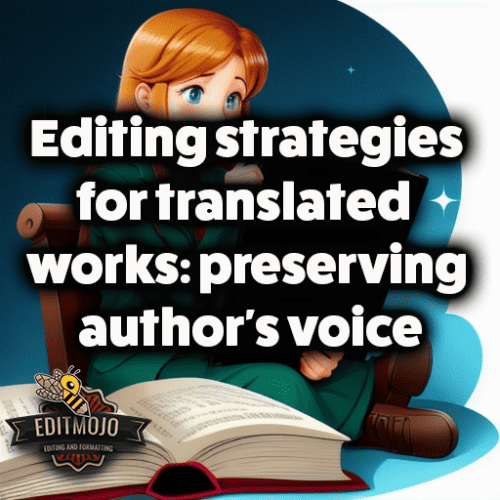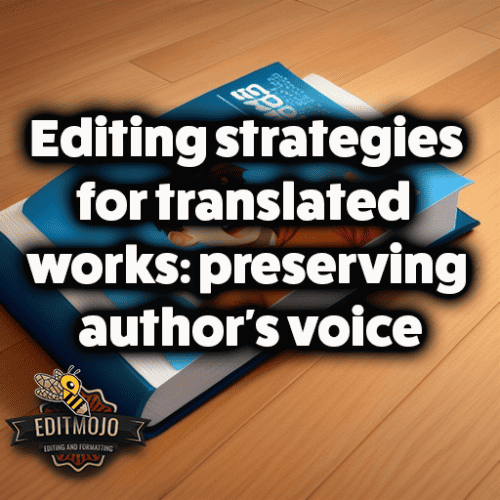Editing strategies for translated works: preserving author’s voice
Editing strategies for translated works: preserving author’s voice. The profound art of translation lies in transferring not just words from one language to another but bridging cultures, ideas, and emotions. Yet, translation is a delicate and nuanced process; the essence and tone of an author can often become lost in the shuffle. Therefore, preserving the author’s voice becomes the quintessence of an exceptional translation.
This article intends to delve deep into the realm of editing translated works, exploring the unique strategies involved in ensuring the author’s voice remains resolute and true, even in a language alien to the original text.
Key Takeaways
| Key Point | Explanation |
|---|---|
| Importance of preserving author’s voice | Retaining the author’s voice in translated works ensures the core essence, tone, and unique style of the author are effectively communicated to the readers in the target language. |
| Balance between fidelity and freedom | Translators and editors must maintain a delicate balance, ensuring faithfulness to the original text while making it accessible and engaging for the target audience. |
| Role of editors | Editors act as quality control agents, fine-tuning the translated work to convey the original tone, style, and emotion appropriately. |
| Techniques for preserving the author’s voice | Techniques include detailed analysis of tone and style, consistency in translating character speech and narrative, and balancing cultural adaptation with cultural preservation. |
| Impact of technology | Technology like AI can assist in translation and editing, but it lacks the subtlety and nuance that a human translator or editor can provide. |
The Concept of Author’s Voice in Literature
‘Author’s voice’ is a literary term referring to the individual writing style of an author, a combination of their syntax, diction, punctuation, character development, dialogue, etc. Think of it as a musical instrument; each has a distinct sound, unique and identifiable. Just as a virtuoso is recognized by their singular performance style, an author is often identified by their ‘voice’ in literature.
Preserving an author’s voice in translation is a monumental task that entails balancing the fidelity to the original text while making it accessible and relatable to the target audience. The essential vibrancy and uniqueness of the text should remain intact, even when clothed in a new language.

The Challenges of Translation: Beyond Literal Meaning
Translation is not merely about replacing words with their counterparts in another language. It involves interpreting cultural nuances, local idioms, and metaphors that do not always have an equivalent in the target language. Achieving this delicate balance between fidelity and freedom can be a translator’s most significant challenge.
For instance, consider Gabriel Garcia Marquez’s novel, “One Hundred Years of Solitude” (Amazon link). The English translation, crafted by Gregory Rabassa, skillfully maintained Marquez’s lyrical prose and magical realism, winning widespread acclaim and even Marquez’s own endorsement.
The Role of Editors in Translated Works
While translators convert text from one language to another, editors wield a different kind of power. They are the quality control agents, fine-tuning the translated work to ensure the original tone, style, and emotion are conveyed appropriately. Their roles often overlap, with both professionals needing an in-depth understanding of the source and target languages.
Techniques for Preserving the Author’s Voice
Several techniques can be employed to retain the author’s voice. A detailed analysis of tone and style in the source language helps capture the author’s unique voice. Consistency is crucial in translating character speech and narrative, as changes can distort the author’s intended portrayal.
The dichotomy of cultural adaptation vs. cultural preservation is another pivotal factor. For example, in Haruki Murakami’s “Norwegian Wood” (Amazon link), translator Jay Rubin had to find a balance between maintaining Japanese cultural nuances while making the novel accessible to a global audience.
Case Studies: Successful Translations and their Editing Strategies
Let’s explore the realm of successful translations and the editing strategies behind them. One standout example is the work of Edith Grossman, renowned for translating works of Gabriel Garcia Marquez and Mario Vargas Llosa. Grossman’s technique of immersing herself fully in the author’s world is a testament to the dedication required for the craft. This deep understanding enables her to render an English text that retains the vibrancy and spirit of the original.
Another case study is the English translation of the famous Chinese novel, “Journey to the West”. Translator Anthony C. Yu’s (Wikipedia link) careful translation and meticulous footnotes provided much-needed cultural context to Western readers, while retaining the humorous and playful tone of the original text.

Collaboration Between Editors and Translators
The best translations often result from a harmonious collaboration between editors and translators. They should share a unified vision of presenting a translation that encapsulates the author’s original intent and voice. This partnership forms a symbiotic relationship where each expert enhances the other’s work.
The Impact of Technology on Editing Translated Works
In an era of digital evolution, translation and editing are no exceptions to technological influence. Tools like Google Translate or DeepL (DeepL link) can provide a rough translation, yet they often lack the subtlety and nuance that a human translator brings. The application of AI in translation and editing might significantly shape the future, but for now, the human touch remains irreplaceable.
Concluding Thoughts
In conclusion, preserving the author’s voice in translated works is a dance between languages, a collaboration of minds, and a testament to the universal appeal of storytelling. It is a celebration of linguistic diversity and cultural richness. So, the next time you read a translated work, spare a moment to appreciate the intricate craft of translation and editing that brings global literature to your doorstep.

References (Editing strategies for translated works: preserving author’s voice)
For further exploration into the world of translation and editing, the works of David Bellos (“Is That a Fish in Your Ear?”) and Edith Grossman (“Why Translation Matters”) provide deep insights into the craft.
Top Five Questions and Answers
1. Why is preserving the author’s voice in translated works important?
Preserving the author’s voice is crucial as it maintains the unique style, tone, and emotional depth of the original text. It ensures that readers in different languages can enjoy and appreciate the author’s original intent and expression.
2. What challenges can translators face when trying to preserve the author’s voice?
Translators can face difficulties in maintaining the balance between literal translation and capturing the spirit of the text. Cultural nuances, idioms, metaphors, and other language-specific elements can also pose challenges in translation.
3. How can editors help in preserving the author’s voice in translated works?
Editors can fine-tune the translated work to ensure it accurately represents the original tone, style, and emotions of the author. They work to maintain consistency in character speech and narrative, and they help balance cultural adaptation with cultural preservation.
4. How does technology impact the translation and editing process?
Translation and editing tools can provide initial translations and help with grammar and syntax. However, they often lack the ability to interpret and reproduce nuances and subtlety. For now, human translators and editors remain essential for high-quality translations.
5. Can you give an example of a successful translation that preserved the author’s voice?
One example is Gregory Rabassa’s translation of Gabriel Garcia Marquez’s “One Hundred Years of Solitude”. Rabassa was successful in maintaining Marquez’s unique voice, filled with lyrical prose and magical realism.
